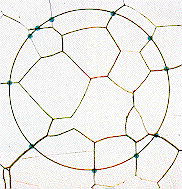|
|
Grain
size in a sample can be measured by determining the mean chord length of
its constituent grains. After polishing and etching to reveal the grains
of the material a line of known length is projected onto the surface and
the mean chord length, < L >, is determined from the reciprocal of the
number of intersections, N, of the line with grain boundaries per unit
line length. < L > = 1/ N.
The
photograph shows a circle of 50 mm diameter projected onto a polycrystalline
sample magnified x 250. The effective circumference of the circle has a
length of 0.63 mm and there are 11 intersections of this with grain boundaries.
The value of N is
(11/
0.63) = 17.5/ mm, which gives
<
L > = 0.057 mm.
The
grain boundary area per unit volume, A, is given by: A
= 2N. For the sample shown the grain boundary
are per unit volume is 35 mm2/
mm3. |
|
|
|
|
|
|
|
